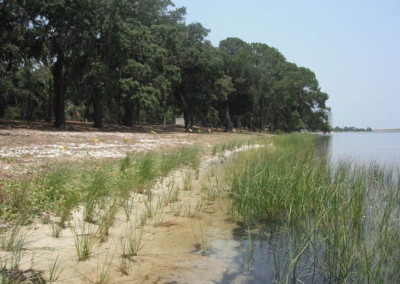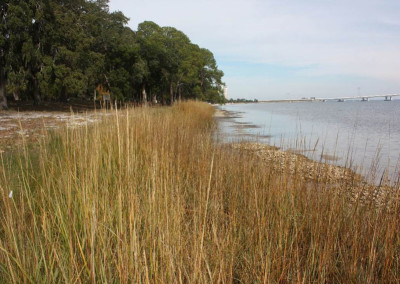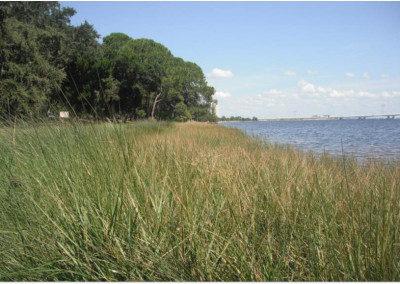Naval Support Activity
This LSL example includes both saltmarsh vegetation and oyster reef breakwater. It was constructed at Naval Support Activity, a military installation in Panama City along St. Andrew Bay. Although the project area is exposed to a long fetch (more than 5 miles), the waves travel across a broad, shallow coastal shelf, such that the shoreline does not usually experience high wave energy.
Although we are usually working on smaller stretches of shoreline, this project included three segments of shoreline that were 800, 900, and 1400 feet long. About 200 oyster reefs were installed using loose, unconsolidated shell.
The project began with a lot of debris removal, including downed trees, exposed roots, and a concrete slab. Reefs were constructed in October and December 2010. Plants were planted and thriving by June 2011, and had filled in completely by September 2013. More than 600 civilian and military volunteers worked nearly 3000 hours to make this project happen, and two high schools helped grow the 21,000+ plants required.
Initially, the Navy had been exploring options, including hardening with rip-rap, to stabilize a 900-foot stretch of eroding shoreline, but they decided instead to take a greener approach. This particular project has garnered Naval Support Activity multiple awards, including the EPA Gulf Guardian Partnership Award in 2013.
The initial project timeline had to be revised due to permit modifications and uncertainty related to potential impacts of the Deep Water Horizon oil spill in 2010.
Plants, listed in order of position from wetland to upland:
Spartina alterniflora (smooth cordgrass)
Juncus roemerianus (black needle rush)
Spartina patens (saltmeadow cordgrass)
Baccharis halimifolia (saltbush)





